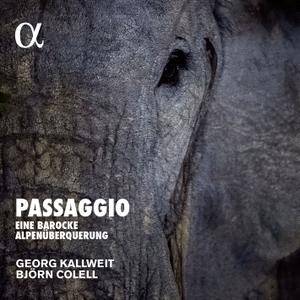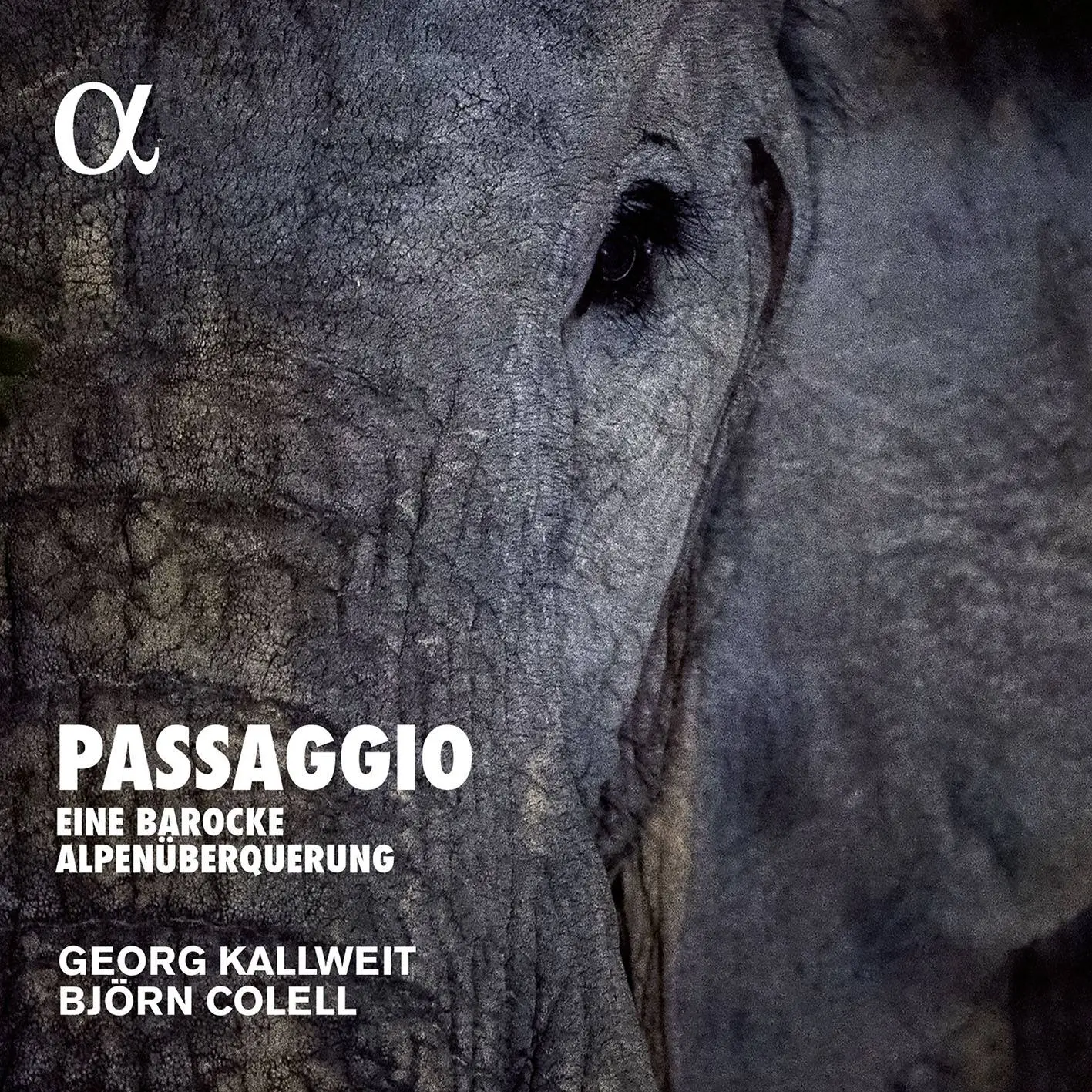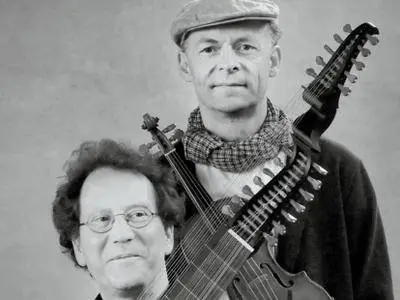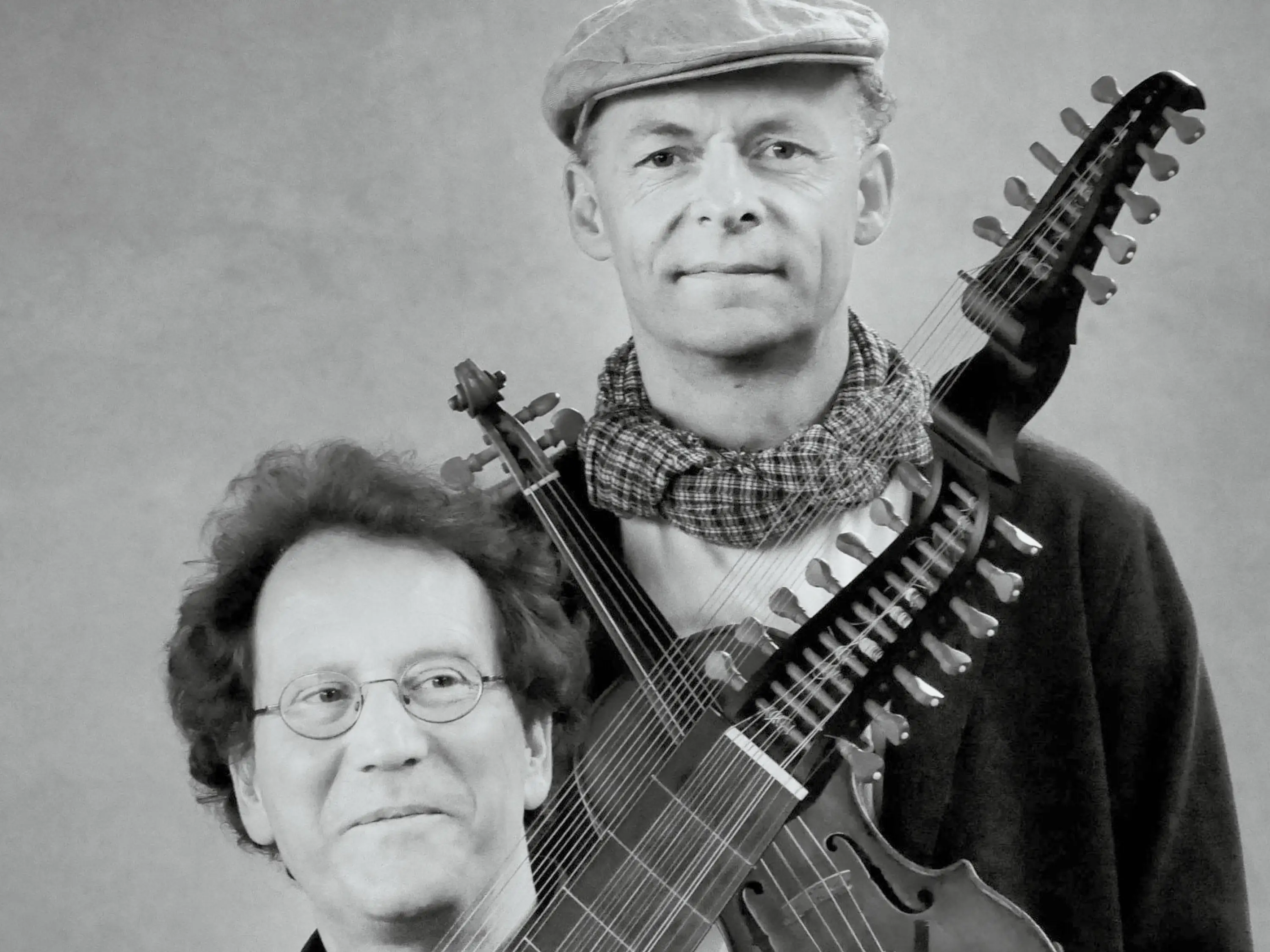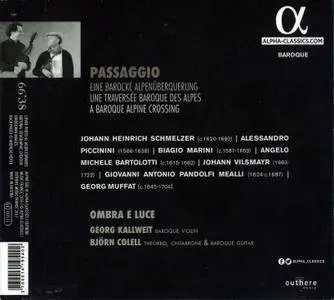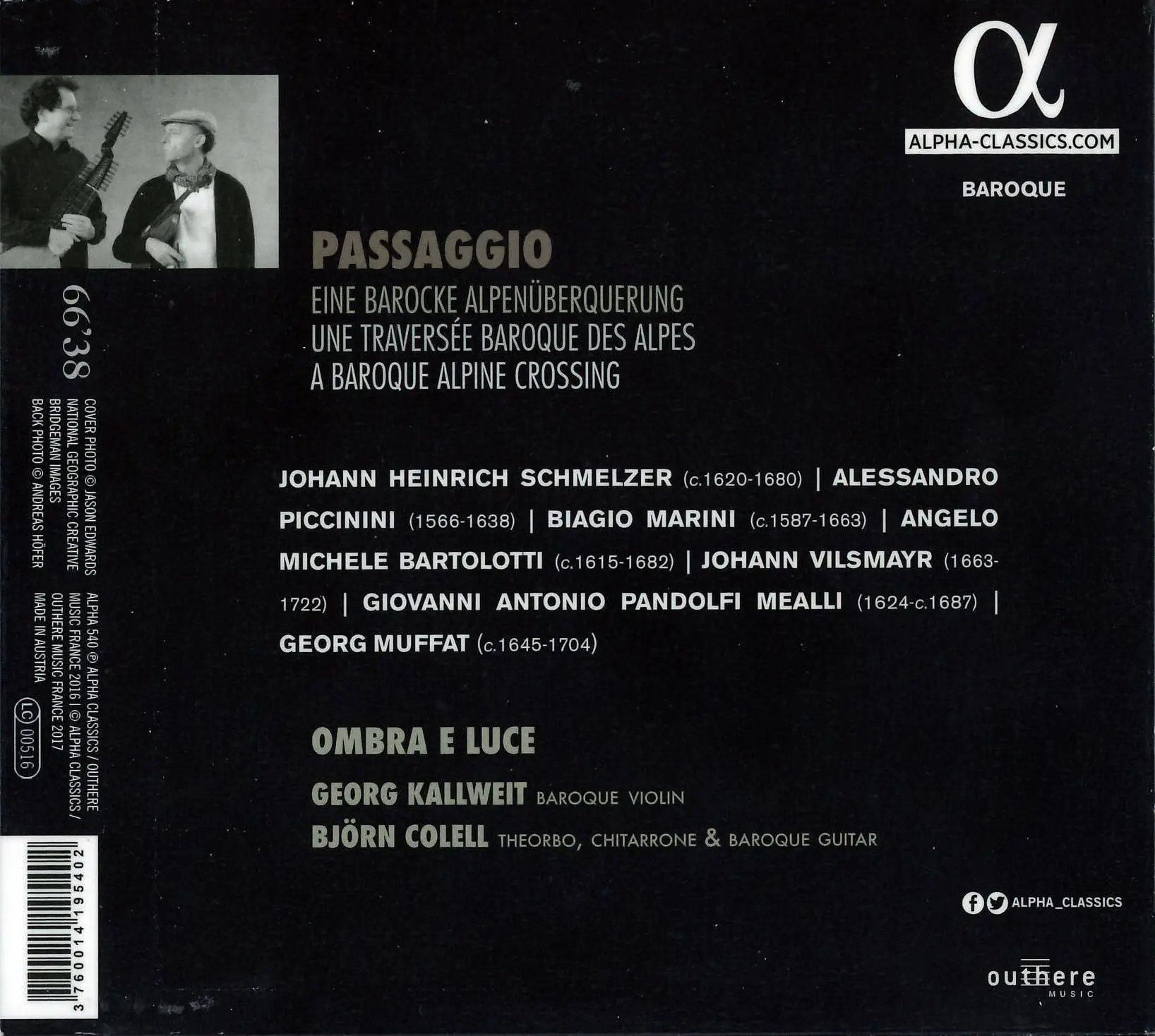Georg Kallweit, Björn Colell - Passaggio: Eine Barocke Alpenüberquerung (2017)
works by Schmelzer, Piccinini, Marini, Bartolotti, Vilsmayr, Pandolfi Mealli, Muffat
EAC | FLAC | Image (Cue&Log) ~ 326 Mb | Mp3 (CBR320) ~ 157 Mb | Artwork included
Genre: Classical | Label: Alpha Classics | # ALPHA 540 | Time: 01:06:43
works by Schmelzer, Piccinini, Marini, Bartolotti, Vilsmayr, Pandolfi Mealli, Muffat
EAC | FLAC | Image (Cue&Log) ~ 326 Mb | Mp3 (CBR320) ~ 157 Mb | Artwork included
Genre: Classical | Label: Alpha Classics | # ALPHA 540 | Time: 01:06:43
For several years now, the guitarist and lutenist Björn Colell and the Baroque violinist Georg Kallweit, Konzertmeister of the Akademie für Alte Musik Berlin, have formed a noted duo called Ombra e Luce: ‘With only two musicians and two instruments, we aspire to a perfect rapport and a permanent dialogue. We have access to a rich repertory of original pieces from the sixteenth to eighteenth centuries for violin and lute/theorbo: this was a widespread combination, essentially before 1700. We work a great deal on tone colours and nuances, spontaneity and improvisatory playing – a flexible and sensual interpretation of the works we perform, giving full value to chiaroscuro: ombra e luce! We are convinced that, played in this way, our “early music” can speak directly to the hearts even of listeners who are hearing it for the first time. This new recording, “Passagio”, is the result of our recent musical journeys. Setting out from Italy to go farther north, we have virtually and musically crossed the Alps with our instruments. The works on this recording shed a different light on the music of the courts of Modena, Bologna and Venice.’
The stile nuovo which emerged in Italy in the early 17th century, found a wide appeal across Europe, in particular in the German-speaking world. One of its features was instrumental virtuosity, especially in music written for the violin. The present disc includes some specimens of the Italian influence in music written above the Alps.
It is fitting that the programme opens with a piece by Johann Heinrich Schmelzer. He can be considered one of the founders of the German-Austrian violin school which mixed the new Italian style with the German contrapuntal tradition. He probably was a pupil of Antonio Bertali, who for more than 40 years was in the service of the imperial court in Vienna where Schmelzer also worked most of his life. A popular composition device in Italy was the use of a basso ostinato, the repetition of the same pattern in the bass over which the treble instrument weaves an increasingly virtuosic web. That is also the case in Schmelzer's Sonata IV from his collection Sonatae unarum fidium of 1664. For three quarters of this piece the bass pattern is a descending sequence of four notes. This episode is divided into various sections. The last section - from 6:00 - the bass leaves the previous pattern and becomes more free; the violin plays in an improvisatory manner. The brilliant closing points in the direction of Biber.
Biagio Marini was one of the first in Italy to compose and publish virtuosic music for a solo instrument. Although most of his published collections are not specifically intended for violin, some clearly point in that direction, for instance the Sonata IV from the Op. 8 of 1629, as here he makes use of double stopping. Marini is notable for this technique; most Italian composers of later generations seem to have avoided it. That was very different in the German-speaking world where it became a fixed part of composing for the violin. Another feature which had its origin in Italy and found more imitators above the Alps than in Italy itself is descriptive music: the illustration of characters or natural phenomena in instrumental music. The best-known Italian piece of this kind is Carlo Farina's Capriccio stravagante. The programme on this disc includes an anonymous specimen: the Musicalisch Uhrwerck (the musical clock) from a large collection of music for violin, known as Manuscript XIV 726 from the Minorite Convent in Vienna. This piece again includes several passages with a basso ostinato.
In Austria Italian musicians played a key role in music life, not only at the court in Vienna, but also elsewhere. Giovanni Antonio Pandolfi Mealli was from Montepulciano in Tuscany. In the 1650s he entered the service of the Princess de' Medici in Innsbruck. Later he worked in Sicily and in Madrid. Only three collections of music from his pen are known. The most famous are the twelve sonatas which were published as his opp. 3 and 4 respectively, both comprising six sonatas. All sonatas of both collections bear names which mostly refer to musicians from his time, some of whom were Mealli's colleagues in Innsbruck. Whether these are intended as a kind of musical portraits is impossible to say. It could well be that by giving his sonatas a title which is derived from their names Pandolfi Mealli wanted to pay respect to his colleagues. One of these is the castrato Giovanni Giacomo Biancucci to whom the Sonata IV from the Op. 4 La Biancuccia refers.
Little is known about Johann Joseph Vilsmaÿr who hasn't even an entry in New Grove. It is likely that he was a pupil of Heinrich Ignaz Franz von Biber. For most of his life he worked at the court in Salzburg as violinist and as chamberlain to Francisco Antonio, the Archbishop of Salzburg. To him Vilsmaÿr dedicated his six partitas which were printed in Salzburg in 1715. This is the only collection of music from his pen which has come down to us, alongside a sonata for violin and bc. The title page includes the words "con basso bellè imitante" which has been interpreted as referring to a (lost) basso continuo part. However, this merely indicates that a bass line is suggested, through the use of counterpoint and the quick succession of high and low notes. Unfortunately the track-list is not very specific about the pieces included here. The collection comprises six suites, called Partia, but here we don't get a key which makes it impossible to tell which of the suites is played. The second movement is called Harpeggio but in the recording by Vaughan Jones none of the movements bears this title. In any case we don't hear a complete suite: the number of movements of these suites varies from eight to eleven.
The last piece in the programme is from the pen of Georg Muffat, a promotor of the 'mixed taste', who had first hand experience in both the French and the Italian style. The Sonata in D is his only piece for this scoring and is preserved in the archive of the Bishop of Olomouc in Kromeriz. It was written in 1677, as the manuscript shows, which means that it predates the sonatas of Corelli. As the sonata by Marini it is an example of the stylus phantasticus: it comprises five movements of contrasting tempo and character - adagio, allegro, adagio, allegro, adagio - but these are not formally divided and follow each other attacca. It is notable that Muffat completely avoids double stopping.
In between we hear some lute and guitar pieces. To some extent they don't fit well into the programme, in that lute music in the German-speaking world was under the influence of French rather than Italian lute music. However, the pieces for plucked instruments by Piccinini and Bartolotti can be considered further demonstrations of the Italian style. The chitarrone was one of the most revered plucked instruments in Italy. Piccinini was a true virtuoso, at the same level as his younger colleague Giovanni Girolamo Kapsperger. The three pieces represent several genres of music for solo instruments. The Toccata X has a strongly improvisatory character, not unlike toccatas for keyboard by, for instance, Frescobaldi. Angelo Michele Bartolotti was from Bologna and was a theorbo player. However, he also played the guitar - chitarra spagnola - which had come to Italy mainly through Naples, which was under Spanish rule. Björn Colell has selected several pieces from two collections and ordered them in the form of a suite. That is a bit odd as the suite was a French invention and did not appear in Italy.
Georg Kallweit is one of the leaders of the world-class Akademie für Alte Musik Berlin, known for its engaging and colourful performances. That is what we get here as well. Kallweit plays with technical assurance and great intensity, differentiating in colours and dynamics. The result is a compelling programme which makes one long for more. What we get here is just a very tiny selection from the incredibly rich repertoire of music for violin from Italy and the German-speaking world. Colell is Kallweit's congenial partner and delivers fine performances of the solo pieces for chitarrone and for guitar.Review by Johan van Veen, MusicWeb-International.com
Georg Kallweit - baroque violin
Björn Colell - theorbo, chitarrone & baroque guitar
Björn Colell - theorbo, chitarrone & baroque guitar
rec. Polditz, Germany, 11-13 July 2016
Tracklist:
Johann Heinrich Schmelzer (c.1620-1680)
01. Sonatae unarum fidium - Sonata IV (8:43)
Alessandro Piccinini (1566-1638)
02. Tenore detto il mercatello, Corrente detto nasazzo fatta sopra il mercatello, Toccata X (6:46)
Biagio Marini (c.1587-1663)
03. Sonata Quarta 'Per il violino per sonar con due corde', Op.VIII (9:36)
Anonymous
04. Musicalisch Uhrwerk (6:02)
Angelo Michele Bartolotti (c.1615-1682)
05. Prelude, allemande, courante, sarabande, passacaglia (7:25)
Johann Joseph Vilsmayr (1663-1722)
06. Partita for Violino senza Basso (8:29)
Giovanni Antonio Pandolfi Mealli (1624-c.1687)
07. Violin Sonatas, Op.4 - IV. La Biancuccia (7:43)
Georg Muffat (c.1645-1704)
08. Violin Sonata in D major (12:00)
Exact Audio Copy V1.3 from 2. September 2016
EAC extraction logfile from 9. May 2018, 22:30
Georg Kallweit, Björn Colell / Passagio
Used drive : PLDS DVD-RW DU8A6SH Adapter: 1 ID: 0
Read mode : Secure
Utilize accurate stream : Yes
Defeat audio cache : Yes
Make use of C2 pointers : No
Read offset correction : 6
Overread into Lead-In and Lead-Out : No
Fill up missing offset samples with silence : Yes
Delete leading and trailing silent blocks : No
Null samples used in CRC calculations : Yes
Used interface : Native Win32 interface for Win NT & 2000
Used output format : User Defined Encoder
Selected bitrate : 128 kBit/s
Quality : High
Add ID3 tag : No
Command line compressor : C:\Program Files (x86)\Exact Audio Copy\Flac\flac.exe
Additional command line options : -V -8 -T "Date=%year%" -T "Genre=%genre%" %source%
TOC of the extracted CD
Track | Start | Length | Start sector | End sector
––––––––––––––––––––––––––––-
1 | 0:00.00 | 8:42.42 | 0 | 39191
2 | 8:42.42 | 6:46.23 | 39192 | 69664
3 | 15:28.65 | 9:36.14 | 69665 | 112878
4 | 25:05.04 | 6:01.39 | 112879 | 139992
5 | 31:06.43 | 7:24.60 | 139993 | 173352
6 | 38:31.28 | 8:28.50 | 173353 | 211502
7 | 47:00.03 | 7:42.65 | 211503 | 246217
8 | 54:42.68 | 11:59.67 | 246218 | 300209
Range status and errors
Selected range
Filename C:\temp\Alpha 540 - Passaggio\Passagio.wav
Peak level 96.6 %
Extraction speed 3.8 X
Range quality 100.0 %
Test CRC 8C956F6C
Copy CRC 8C956F6C
Copy OK
No errors occurred
AccurateRip summary
Track 1 accurately ripped (confidence 1) [A8CF8135] (AR v2)
Track 2 accurately ripped (confidence 1) [7FB63CE3] (AR v2)
Track 3 accurately ripped (confidence 1) [7201DB90] (AR v2)
Track 4 accurately ripped (confidence 1) [3372D983] (AR v2)
Track 5 accurately ripped (confidence 1) [215E0A53] (AR v2)
Track 6 accurately ripped (confidence 1) [9830FF3C] (AR v2)
Track 7 accurately ripped (confidence 1) [E4427CF3] (AR v2)
Track 8 accurately ripped (confidence 1) [33D1BC64] (AR v2)
All tracks accurately ripped
End of status report
==== Log checksum 90A500939FC3C61316B15BBD7AC2AA2CD9D2B61DAF9B42D9DEAB227BED9F388C ====
EAC extraction logfile from 9. May 2018, 22:30
Georg Kallweit, Björn Colell / Passagio
Used drive : PLDS DVD-RW DU8A6SH Adapter: 1 ID: 0
Read mode : Secure
Utilize accurate stream : Yes
Defeat audio cache : Yes
Make use of C2 pointers : No
Read offset correction : 6
Overread into Lead-In and Lead-Out : No
Fill up missing offset samples with silence : Yes
Delete leading and trailing silent blocks : No
Null samples used in CRC calculations : Yes
Used interface : Native Win32 interface for Win NT & 2000
Used output format : User Defined Encoder
Selected bitrate : 128 kBit/s
Quality : High
Add ID3 tag : No
Command line compressor : C:\Program Files (x86)\Exact Audio Copy\Flac\flac.exe
Additional command line options : -V -8 -T "Date=%year%" -T "Genre=%genre%" %source%
TOC of the extracted CD
Track | Start | Length | Start sector | End sector
––––––––––––––––––––––––––––-
1 | 0:00.00 | 8:42.42 | 0 | 39191
2 | 8:42.42 | 6:46.23 | 39192 | 69664
3 | 15:28.65 | 9:36.14 | 69665 | 112878
4 | 25:05.04 | 6:01.39 | 112879 | 139992
5 | 31:06.43 | 7:24.60 | 139993 | 173352
6 | 38:31.28 | 8:28.50 | 173353 | 211502
7 | 47:00.03 | 7:42.65 | 211503 | 246217
8 | 54:42.68 | 11:59.67 | 246218 | 300209
Range status and errors
Selected range
Filename C:\temp\Alpha 540 - Passaggio\Passagio.wav
Peak level 96.6 %
Extraction speed 3.8 X
Range quality 100.0 %
Test CRC 8C956F6C
Copy CRC 8C956F6C
Copy OK
No errors occurred
AccurateRip summary
Track 1 accurately ripped (confidence 1) [A8CF8135] (AR v2)
Track 2 accurately ripped (confidence 1) [7FB63CE3] (AR v2)
Track 3 accurately ripped (confidence 1) [7201DB90] (AR v2)
Track 4 accurately ripped (confidence 1) [3372D983] (AR v2)
Track 5 accurately ripped (confidence 1) [215E0A53] (AR v2)
Track 6 accurately ripped (confidence 1) [9830FF3C] (AR v2)
Track 7 accurately ripped (confidence 1) [E4427CF3] (AR v2)
Track 8 accurately ripped (confidence 1) [33D1BC64] (AR v2)
All tracks accurately ripped
End of status report
==== Log checksum 90A500939FC3C61316B15BBD7AC2AA2CD9D2B61DAF9B42D9DEAB227BED9F388C ====
[CUETools log; Date: 13.05.2018 21:29:17; Version: 2.1.4]
[CTDB TOCID: 1KD65rj6Bgus1OW.CDbP1AO7pXc-] found.
Track | CTDB Status
1 | (7/7) Accurately ripped
2 | (7/7) Accurately ripped
3 | (7/7) Accurately ripped
4 | (7/7) Accurately ripped
5 | (7/7) Accurately ripped
6 | (7/7) Accurately ripped
7 | (7/7) Accurately ripped
8 | (7/7) Accurately ripped
[AccurateRip ID: 0013bad5-0083b35e-650fa208] found.
Track [ CRC | V2 ] Status
01 [e90cfcef|a8cf8135] (0+1/1) Accurately ripped
02 [6c256f72|7fb63ce3] (0+1/1) Accurately ripped
03 [ca4b35dc|7201db90] (0+1/1) Accurately ripped
04 [0b1a0654|3372d983] (0+1/1) Accurately ripped
05 [69f83bf0|215e0a53] (0+1/1) Accurately ripped
06 [d5afbae9|9830ff3c] (0+1/1) Accurately ripped
07 [a5c2d424|e4427cf3] (0+1/1) Accurately ripped
08 [35f8289e|33d1bc64] (0+1/1) Accurately ripped
Track Peak [ CRC32 ] [W/O NULL] [ LOG ]
– 96,6 [8C956F6C] [14223F5C] CRC32
01 95,1 [AD7CEA1E] [7B60F060]
02 62,0 [6BE240FF] [861F7DBC]
03 95,0 [3369B566] [E927F04E]
04 96,6 [9BE4B20A] [7CA2274E]
05 93,4 [D8050CEC] [67F88F19]
06 61,0 [6D0A2151] [BC93C489]
07 95,2 [372F34EC] [9FAB130E]
08 78,5 [0EF7F00B] [03DD6082]
[CTDB TOCID: 1KD65rj6Bgus1OW.CDbP1AO7pXc-] found.
Track | CTDB Status
1 | (7/7) Accurately ripped
2 | (7/7) Accurately ripped
3 | (7/7) Accurately ripped
4 | (7/7) Accurately ripped
5 | (7/7) Accurately ripped
6 | (7/7) Accurately ripped
7 | (7/7) Accurately ripped
8 | (7/7) Accurately ripped
[AccurateRip ID: 0013bad5-0083b35e-650fa208] found.
Track [ CRC | V2 ] Status
01 [e90cfcef|a8cf8135] (0+1/1) Accurately ripped
02 [6c256f72|7fb63ce3] (0+1/1) Accurately ripped
03 [ca4b35dc|7201db90] (0+1/1) Accurately ripped
04 [0b1a0654|3372d983] (0+1/1) Accurately ripped
05 [69f83bf0|215e0a53] (0+1/1) Accurately ripped
06 [d5afbae9|9830ff3c] (0+1/1) Accurately ripped
07 [a5c2d424|e4427cf3] (0+1/1) Accurately ripped
08 [35f8289e|33d1bc64] (0+1/1) Accurately ripped
Track Peak [ CRC32 ] [W/O NULL] [ LOG ]
– 96,6 [8C956F6C] [14223F5C] CRC32
01 95,1 [AD7CEA1E] [7B60F060]
02 62,0 [6BE240FF] [861F7DBC]
03 95,0 [3369B566] [E927F04E]
04 96,6 [9BE4B20A] [7CA2274E]
05 93,4 [D8050CEC] [67F88F19]
06 61,0 [6D0A2151] [BC93C489]
07 95,2 [372F34EC] [9FAB130E]
08 78,5 [0EF7F00B] [03DD6082]
foobar2000 1.2 / Dynamic Range Meter 1.1.1
log date: 2018-05-13 21:20:14
––––––––––––––––––––––––––––––––––––––––
Analyzed: Björn Colell / Passagio
––––––––––––––––––––––––––––––––––––––––
DR Peak RMS Duration Track
––––––––––––––––––––––––––––––––––––––––
DR14 -4.15 dB -23.68 dB 6:46 02-Piccinini: Tenore detto il mercatello, Corrente detto nasazzo fatta sopra il mercatello, Toccata X
DR17 -0.59 dB -22.40 dB 7:25 05-Bartolotti: Prelude, allemande, courante, sarabande, passacaglia
––––––––––––––––––––––––––––––––––––––––
Number of tracks: 2
Official DR value: DR16
Samplerate: 44100 Hz
Channels: 2
Bits per sample: 16
Bitrate: 674 kbps
Codec: FLAC
================================================================================
––––––––––––––––––––––––––––––––––––––––
Analyzed: Georg Kallweit, Björn Colell / Passagio
––––––––––––––––––––––––––––––––––––––––
DR Peak RMS Duration Track
––––––––––––––––––––––––––––––––––––––––
DR16 -0.44 dB -20.79 dB 8:43 01-Schmelzer: Sonatae unarum fidium - Sonata IV
DR15 -0.45 dB -21.00 dB 9:36 03-Marini: Sonata Quarta 'Per il violino per sonar con due corde', Op.VIII
DR17 -0.30 dB -20.80 dB 6:02 04-Anonymous: Musicalisch Uhrwerk
DR15 -0.42 dB -19.61 dB 7:43 07-Pandolfi Mealli: Violin Sonatas, Op.4 - IV. La Biancuccia
DR14 -2.10 dB -21.07 dB 12:00 08-Muffat: Violin Sonata in D major
––––––––––––––––––––––––––––––––––––––––
Number of tracks: 5
Official DR value: DR16
Samplerate: 44100 Hz
Channels: 2
Bits per sample: 16
Bitrate: 674 kbps
Codec: FLAC
================================================================================
––––––––––––––––––––––––––––––––––––––––
Statistics for: 06-Vilsmayr: Partita for Violino senza Basso
Number of samples: 22432200
Duration: 8:29
––––––––––––––––––––––––––––––––––––––––
Left Right
Peak Value: -4.29 dB –- -5.04 dB
Avg RMS: -23.64 dB –- -24.08 dB
DR channel: 13.73 dB –- 14.23 dB
––––––––––––––––––––––––––––––––––––––––
Official DR Value: DR14
Samplerate: 44100 Hz
Channels: 2
Bits per sample: 16
Bitrate: 674 kbps
Codec: FLAC
================================================================================
log date: 2018-05-13 21:20:14
––––––––––––––––––––––––––––––––––––––––
Analyzed: Björn Colell / Passagio
––––––––––––––––––––––––––––––––––––––––
DR Peak RMS Duration Track
––––––––––––––––––––––––––––––––––––––––
DR14 -4.15 dB -23.68 dB 6:46 02-Piccinini: Tenore detto il mercatello, Corrente detto nasazzo fatta sopra il mercatello, Toccata X
DR17 -0.59 dB -22.40 dB 7:25 05-Bartolotti: Prelude, allemande, courante, sarabande, passacaglia
––––––––––––––––––––––––––––––––––––––––
Number of tracks: 2
Official DR value: DR16
Samplerate: 44100 Hz
Channels: 2
Bits per sample: 16
Bitrate: 674 kbps
Codec: FLAC
================================================================================
––––––––––––––––––––––––––––––––––––––––
Analyzed: Georg Kallweit, Björn Colell / Passagio
––––––––––––––––––––––––––––––––––––––––
DR Peak RMS Duration Track
––––––––––––––––––––––––––––––––––––––––
DR16 -0.44 dB -20.79 dB 8:43 01-Schmelzer: Sonatae unarum fidium - Sonata IV
DR15 -0.45 dB -21.00 dB 9:36 03-Marini: Sonata Quarta 'Per il violino per sonar con due corde', Op.VIII
DR17 -0.30 dB -20.80 dB 6:02 04-Anonymous: Musicalisch Uhrwerk
DR15 -0.42 dB -19.61 dB 7:43 07-Pandolfi Mealli: Violin Sonatas, Op.4 - IV. La Biancuccia
DR14 -2.10 dB -21.07 dB 12:00 08-Muffat: Violin Sonata in D major
––––––––––––––––––––––––––––––––––––––––
Number of tracks: 5
Official DR value: DR16
Samplerate: 44100 Hz
Channels: 2
Bits per sample: 16
Bitrate: 674 kbps
Codec: FLAC
================================================================================
––––––––––––––––––––––––––––––––––––––––
Statistics for: 06-Vilsmayr: Partita for Violino senza Basso
Number of samples: 22432200
Duration: 8:29
––––––––––––––––––––––––––––––––––––––––
Left Right
Peak Value: -4.29 dB –- -5.04 dB
Avg RMS: -23.64 dB –- -24.08 dB
DR channel: 13.73 dB –- 14.23 dB
––––––––––––––––––––––––––––––––––––––––
Official DR Value: DR14
Samplerate: 44100 Hz
Channels: 2
Bits per sample: 16
Bitrate: 674 kbps
Codec: FLAC
================================================================================


